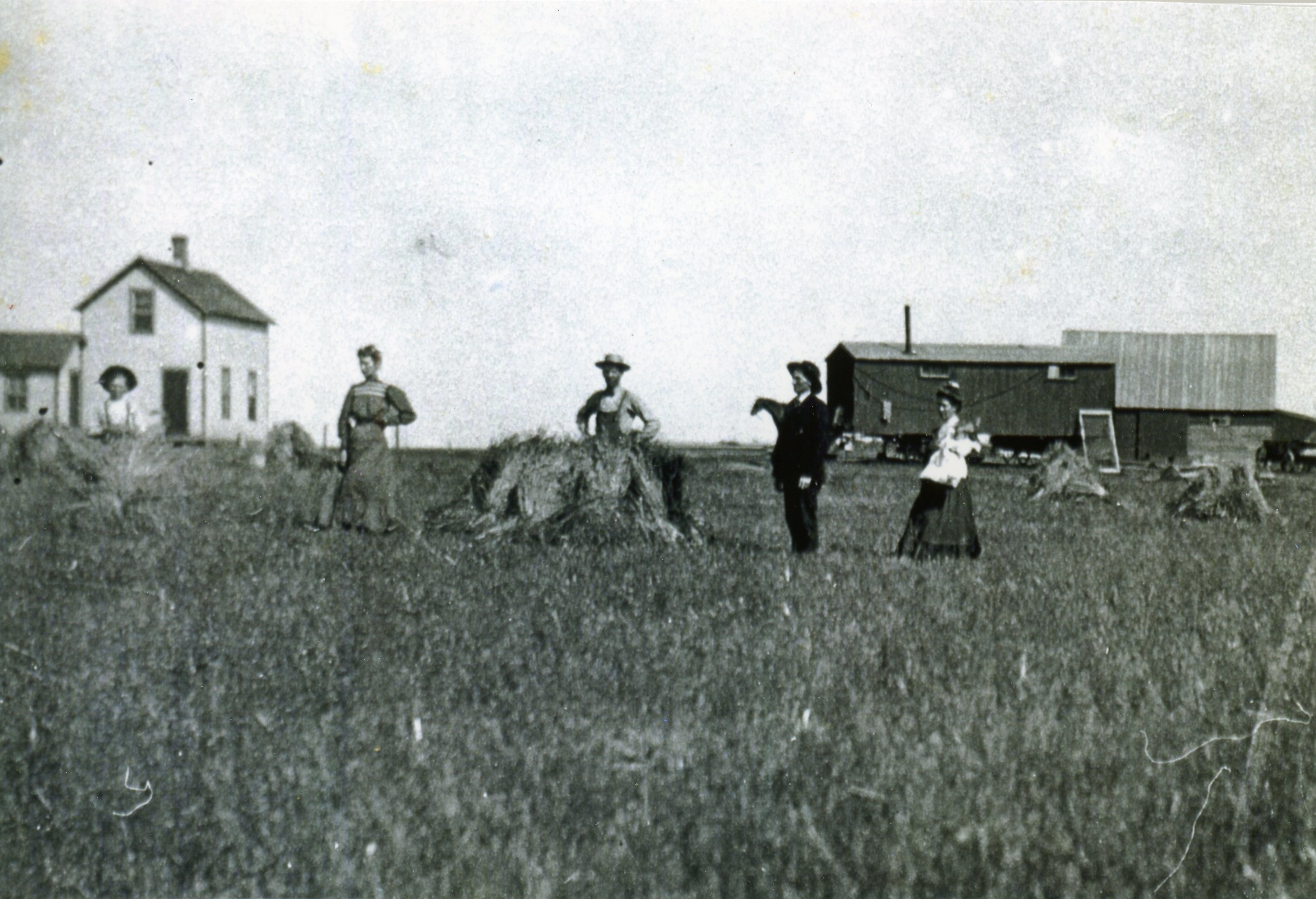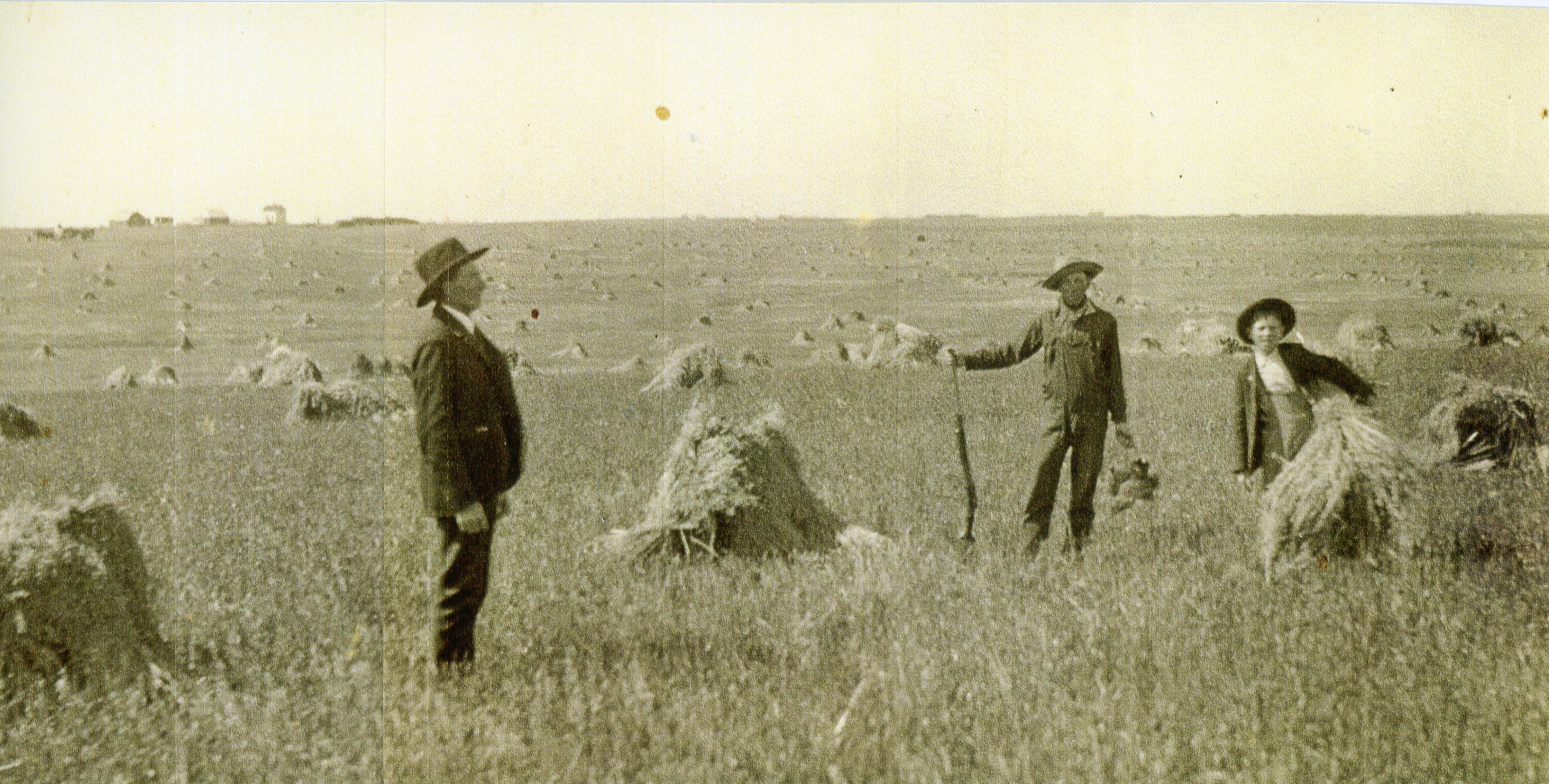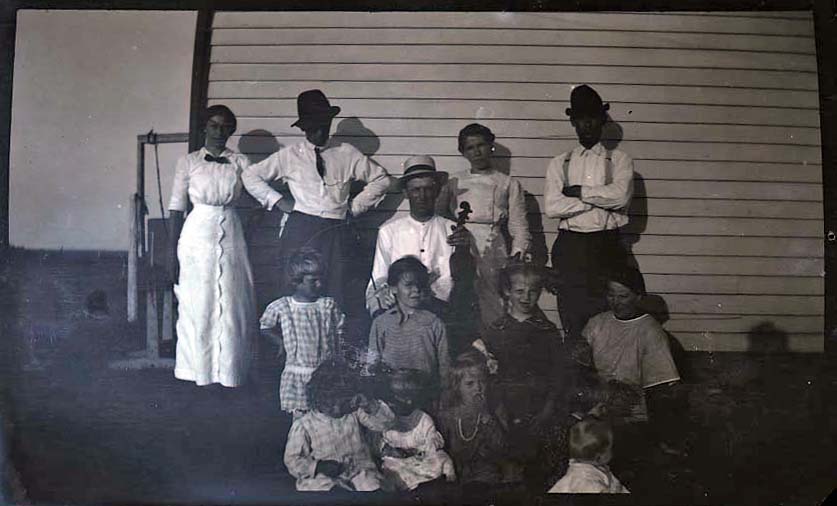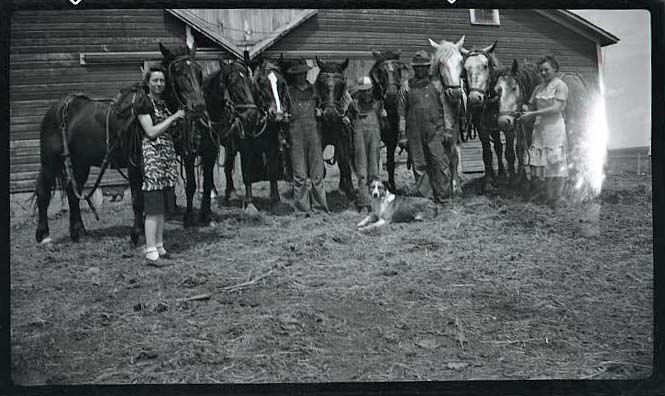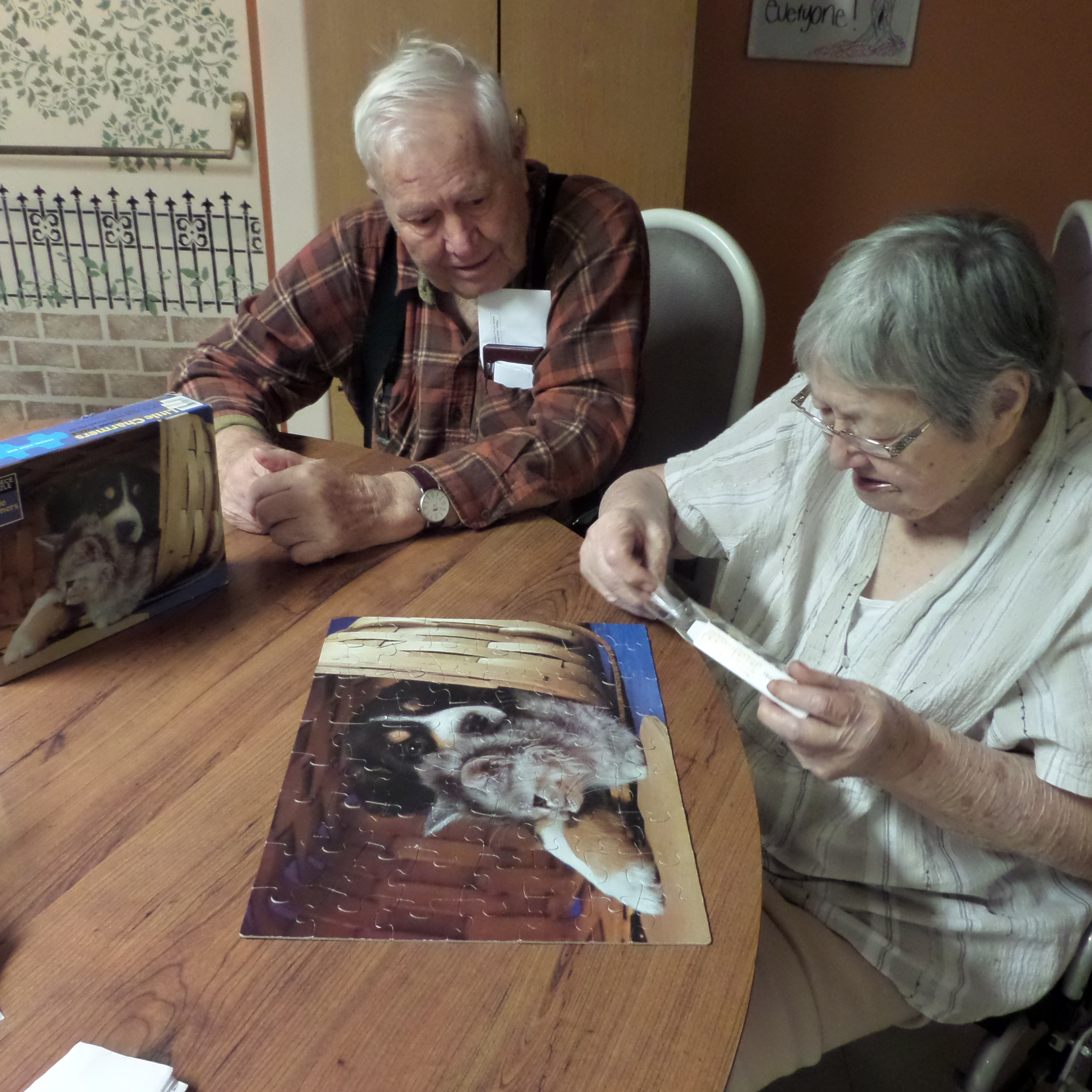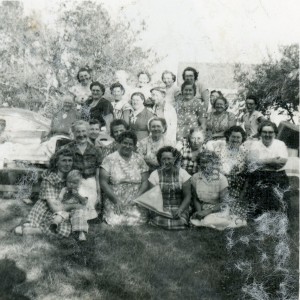“We did some visiting in North Dakota before we left for California…June 22, 1941 at Long Beach. The first time we had our family together for seven years, and also the last….”
Merry Christmas! This blog quite naturally follows two previous blogs about 1940: here and here. UPDATE Dec. 24 post, also related.
Today would have been my Dad’s 106th birthday (born Dec. 22, 1907). Today, his daughter, my sister Mary Ann, arrives on the Big Island of Hawaii from Vanuatu for a visit with her kids and grandkids and our niece Georgine and partner Robert. Her last 15 months in the Peace Corps is chronicled here, the most recent post, Dec. 18, at the end.
It seems a perfect day to recall a June, 1941, trip I took with my family from rural North Dakota to Long Beach California. The narrator is my Dad, Henry, RIP Nov 7, 1997.
I was one year old at the time. The travelers were Grandma and Grandpa Bernard, Mom and Dad, and I.
We traveled by car.
Here’s some background and the “cast of characters”: my parents were age 33 and 31 at the time of the trip; my oldest grandparent, Grandpa Bernard, was 69 (I’m 73, as I write); the youngest, Grandma Busch, was 57. Grandpa Bernard had a love for machines. Fixing a car enroute would have been no problem for him. Mom’s siblings, my Uncle Vince and Aunt Edith, were 16 and 21…. Dad’s sister, Josie, would have been 37; his brother, Frank, 25.
By 1941, Bernard’s were no stranger to travel: Grandpa migrated to North Dakota from Quebec in the 1890s, and in 1898, sailed to the Philippines via Hawaii to be a soldier in the Spanish-American War. Grandma and Grandpa had first gone to Los Angeles in November 1935 for daughter Josie’s wedding. They likely traveled by train, visiting people they knew in Oregon along the way. Beginning in 1937 they became a regular part of the North Dakota winter community in the Los Angeles area, living in Long Beach.
Josie’s husband, Alan Whittaker, had died after surgery only three years or so into their marriage, about 1938. In 1939 she took a major cross-country automobile trip with friends, documenting the route on a 1939 American Automobile Association road map (see below).
For the geographic inclined, here’s a map for reference. The Red and Blue lines are explained here: Josie Bernard trip 1939001
(click to enlarge any photos)
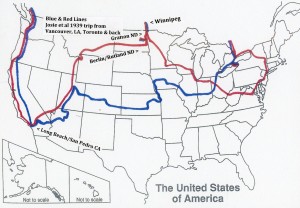
U.S. map showing the 1939 trip route, and the beginning and end points of the 1941 trip.
In 1940-41 Dad was a school teacher in rural Rutland ND. His parents home was Grafton, but since 1937 they had spent a lot of time in Long Beach/LA area where there was already a relatively large North Dakota population.
Mom’s parents lived on a farm near Berlin ND.
Invited by Dad’s parents to go west with them, the decision was made to go to California to visit their daughter and sister, Josie Whittaker, who had lived in Los Angeles since the early 1930s, and was widowed. An apparently unanticipated bonus was to also be able to see their son and brother Frank Bernard, whose ship, the USS Arizona, berthed in nearby San Pedro June 17 – July 1, 1941.
A first stop on the 1941 trip was at the farm of Mom’s parents, Rosa and Ferd Busch:
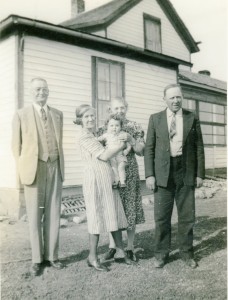
Henry Bernard, Rosa Busch, Richard Bernard, Josephine Bernard, Ferd Busch, at the farm June, 1941
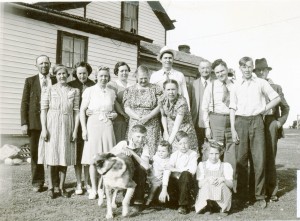
Many of Busch family, and neighbors, pose with the Bernards June, 1941. Note particularly Edith, 3rd from left; Mary, 4th from left, and Vincent 2nd from right. Dad, Mom and Richard (me) are roughly at center.
[at Rutland Consolidated school in SE North Dakota].
They spent a week or so with us and then said that they would buy us another car if we would drive them back to California and spend some time there. We were happy to get this gift so we managed to get to Fargo with our old ’29 Chevy and went to Ford and Dad bought us a ’36 V8 Ford*. It was used but in good condition. It even had a radio in it. [Note the so-called “suicide” back doors. This was our family car for the next 10 years.]

Grandma and Grandpa with Richard and car for the California trip May, 1941
We continued on and reached Las Vegas after dark. We saw all the neon lights of the gambling dens but we were interested only in rest. Had a good supper and then to bed. We had heard that the desert crossing was an adventure and were warned to get started early so we did and made the crossing with any great incident. I remember stopping at a filling station about the middle of the desert and among other things asked for a drink of water This was reluctantly given as water had to be hauled in from miles away.
We reached Long Beach in due time and stayed with the folks in their small apartment. I recall that it had three rooms and a bath and also a front porch. It was set in the alley and there were several attached apartments somewhat like the modern condominiums. It was about two blocks from the beach and we could put on our bathing suits and walk to the beach with ease.
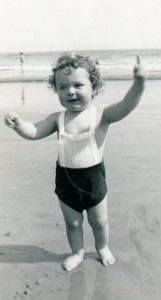
Richard on the beach, Long Beach CA June 1941
[My sister]
Josie was living in Los Angeles and we saw her frequently. We were surprised one day to hear that “the fleets in” [San Pedro] and shortly after my brother Frank [crewman on USS Arizona] came over. He had leave and several times he was in port we had a chance to visit with him and go on trips here and there. Little did we realize that Pearl Harbor was only six months away. [Grandma wrote on the back of the iconic photo of the trip, below: “Taken June 22, 1941 at Long Beach. The first time we had our family together for seven years, and also the last. This is where we lived.”]
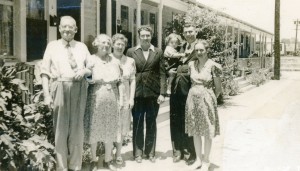
from left, Henry and Josephine Bernard, Josie Bernard Whittaker, Frank, Richard, Henry and Esther Bernard
We left Long Beach on July 5 for the long trip back home. Up the California coast to Oregon and Portland where we visited the Krafts and also the Battleship Oregon [then in repair at Puget Sound Navy Yard, Bremerton WA] and on through Montana and then stopped at Amidon [ND] to visit people we had met there while teaching [1937-39] and then back to the Busch’s before getting on back to Rutland Consolidated where I would be teaching a second year.
I had a chance to do some shocking of grain and threshing before school started. This little bit of extra income was certainly welcome.”
Little more than three months later, Frank Bernard lay dead in the hulk of the USS Arizona.
War was on for the U.S.
Lives had changed dramatically, instantly.
POST NOTES:
How long a trip was it? Assuming Jamestown ND to Long Beach CA, Long Beach to Seattle WA, and Seattle back to Jamestown, and just doing Mapquest as a guide, that single trip was 4268 miles, under far different driving and vehicle conditions than we’re accustomed to today. It is unknown the exact number of days enroute, or in Long Beach, but the assumption is we were gone at least a month, at least ten of these days basically in the automobile, no air conditioning, seat belts, gps, automatic transmission, cruise control, four-lane highways…. It would not have been a simple trip.
Dad was 73, my present age, when he wrote his memoirs in 1981. If you’re thinking you should do something similar, it’s not too late!
Esther’s brother, George (not in the family picture), finished college at Mayville and became a Naval Officer on the Destroyer Woodworth in the Pacific 1943-45, docking at Tokyo Sep 10, 1945. Melvin Berning (the 13 year old to my left in the family picture above, double cousin to my mother, next farm over) saw his brother August off to the Army. August Berning became a Captain in the Pacific theatre.
Unknown to everyone in the pictures, the summer of 1941 was to be the last of peacetime for over four years….
Twenty-five years later, in the summer of 1966, my parents essentially duplicated the 1941 trip with their two-year grandson, my son, Tom. His mother had passed away a year earlier, and I was in summer school at Illinois State U (Normal), and my parents were the sitters-in-residence for Tom. They, along with my brother John and sister Flo, drove to LA (by a different route, if I recall right), thence up the coast and back to ND across Montana as before. Florence was about to begin two years in the Peace Corps in the Dominican Republic, as her older sister, Mary Ann, is now past half way in her own later-life tour in the same Peace Corps.
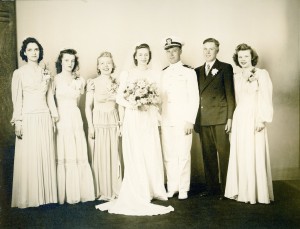
George Busch and Jean Tannahill wedding Thompson ND May 20, 1944. Vincent Busch, George’s brother, was best man, 19 years old at the time.
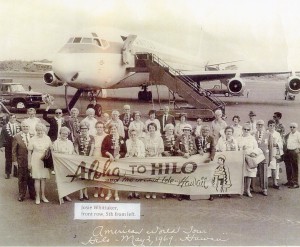
Josie (Bernard) Whittaker and group at Hilo HI May 2, 1969
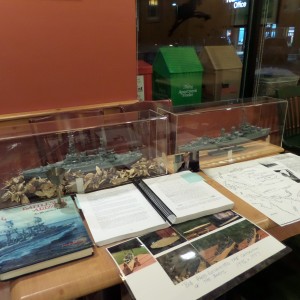
Models of the USS Arizona and USS Woodworth, Frank Bernard and George Busch’s ships in WWII. The Arizona was 608 feet long; the Woodworth, 381 feet. The models were made out of wood blocks by good friend and colleague Bob Tonra in 1996.
